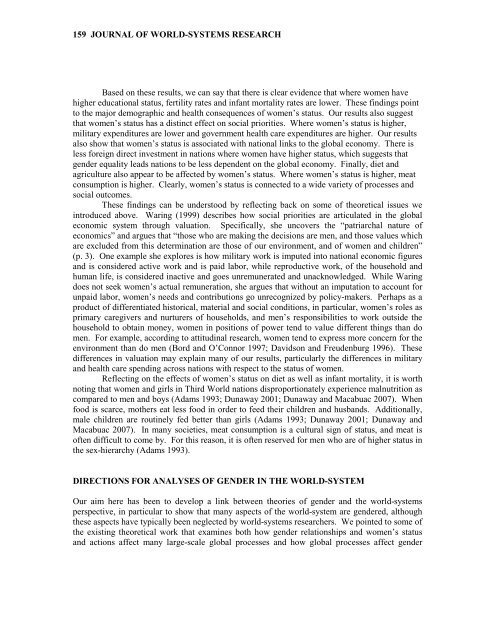Entire Volume 17 issue 1 - Journal of World-Systems Research ...
Entire Volume 17 issue 1 - Journal of World-Systems Research ...
Entire Volume 17 issue 1 - Journal of World-Systems Research ...
You also want an ePaper? Increase the reach of your titles
YUMPU automatically turns print PDFs into web optimized ePapers that Google loves.
159 JOURNAL OF WORLD-SYSTEMS RESEARCH<br />
Based on these results, we can say that there is clear evidence that where women have<br />
higher educational status, fertility rates and infant mortality rates are lower. These findings point<br />
to the major demographic and health consequences <strong>of</strong> women’s status. Our results also suggest<br />
that women’s status has a distinct effect on social priorities. Where women’s status is higher,<br />
military expenditures are lower and government health care expenditures are higher. Our results<br />
also show that women’s status is associated with national links to the global economy. There is<br />
less foreign direct investment in nations where women have higher status, which suggests that<br />
gender equality leads nations to be less dependent on the global economy. Finally, diet and<br />
agriculture also appear to be affected by women’s status. Where women’s status is higher, meat<br />
consumption is higher. Clearly, women’s status is connected to a wide variety <strong>of</strong> processes and<br />
social outcomes.<br />
These findings can be understood by reflecting back on some <strong>of</strong> theoretical <strong>issue</strong>s we<br />
introduced above. Waring (1999) describes how social priorities are articulated in the global<br />
economic system through valuation. Specifically, she uncovers the “patriarchal nature <strong>of</strong><br />
economics” and argues that “those who are making the decisions are men, and those values which<br />
are excluded from this determination are those <strong>of</strong> our environment, and <strong>of</strong> women and children”<br />
(p. 3). One example she explores is how military work is imputed into national economic figures<br />
and is considered active work and is paid labor, while reproductive work, <strong>of</strong> the household and<br />
human life, is considered inactive and goes unremunerated and unacknowledged. While Waring<br />
does not seek women’s actual remuneration, she argues that without an imputation to account for<br />
unpaid labor, women’s needs and contributions go unrecognized by policy-makers. Perhaps as a<br />
product <strong>of</strong> differentiated historical, material and social conditions, in particular, women’s roles as<br />
primary caregivers and nurturers <strong>of</strong> households, and men’s responsibilities to work outside the<br />
household to obtain money, women in positions <strong>of</strong> power tend to value different things than do<br />
men. For example, according to attitudinal research, women tend to express more concern for the<br />
environment than do men (Bord and O’Connor 1997; Davidson and Freudenburg 1996). These<br />
differences in valuation may explain many <strong>of</strong> our results, particularly the differences in military<br />
and health care spending across nations with respect to the status <strong>of</strong> women.<br />
Reflecting on the effects <strong>of</strong> women’s status on diet as well as infant mortality, it is worth<br />
noting that women and girls in Third <strong>World</strong> nations disproportionately experience malnutrition as<br />
compared to men and boys (Adams 1993; Dunaway 2001; Dunaway and Macabuac 2007). When<br />
food is scarce, mothers eat less food in order to feed their children and husbands. Additionally,<br />
male children are routinely fed better than girls (Adams 1993; Dunaway 2001; Dunaway and<br />
Macabuac 2007). In many societies, meat consumption is a cultural sign <strong>of</strong> status, and meat is<br />
<strong>of</strong>ten difficult to come by. For this reason, it is <strong>of</strong>ten reserved for men who are <strong>of</strong> higher status in<br />
the sex-hierarchy (Adams 1993).<br />
DIRECTIONS FOR ANALYSES OF GENDER IN THE WORLD-SYSTEM<br />
Our aim here has been to develop a link between theories <strong>of</strong> gender and the world-systems<br />
perspective, in particular to show that many aspects <strong>of</strong> the world-system are gendered, although<br />
these aspects have typically been neglected by world-systems researchers. We pointed to some <strong>of</strong><br />
the existing theoretical work that examines both how gender relationships and women’s status<br />
and actions affect many large-scale global processes and how global processes affect gender





